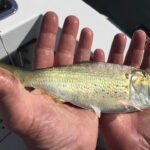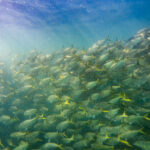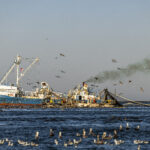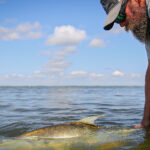
Menhaden Industry Risks Sustainability Certifications
Recent developments in the 2025 Atlantic Menhaden Stock Assessment Update, released by the Atlantic States
Managers Discuss Atlantic Herring, Striped Bass, Menhaden, and Red Drum
By Tony Friedrich, VP/Policy Director
The Atlantic States Marine Fisheries Commission (ASMFC) met last week to discuss several issues key to our members and to east-coast guides and anglers more broadly. There is a lot to cover so let’s get right into it. We will go in meeting order to keep things simple for everyone.
Atlantic Herring: A Long Way To Go
News is not great for this critical forage species. The spawning stock biomass (SSB) in 2021 was just under 40,000 mt. That is only 21% of the target biomass of 185,750 mt. Fishing mortality, however, was only 31% of the overfishing threshold. So, the stock is overfished but not experiencing overfishing. This is due largely to the fact that there are no large year classes coming through, and there haven’t been since the early 2010s. In July, NOAA Fisheries approved a new rebuilding plan that intends to recover the stock by 2026, but that’s dependent on improvements in spawning success in the coming years.
Maine is doing some great biological sampling on Atlantic herring as well as sampling for bycatch, which makes sense because 50% of the coastwide catch is landed in Maine. However, it looks like funding for this sampling, which collects fish from Maine to New Jersey, could run out in 2023, which would negatively impact the stock assessment.
On the federal level (Atlantic herring are jointly managed by the ASMFC and the New England Fishery Management Council), there are several framework adjustments in the works. Adjustment 7 would protect spawning herring on Georges Bank. It has been postponed until the September Council meeting. We will continue to engage on this issue. This species has a long way to go to get back to historical abundance.
Striped Bass
Here we go! A good chunk of this meeting focused on the Striped Bass Board’s preferences regarding rebuilding the stock if additional reductions are needed. This information will help the Technical Committee (TC) develop potential measures once the stock assessment comes out this fall.
We will let the cat out of the bag now. As you may recall from the Amendment 7 process, one of our biggest concerns was no-targeting closures. Why would this be a concern? Well, you can’t enforce no-targeting closures. The amount of fish saved is not quantifiable. So, what’s the point? The only stakeholder group this would hurt are guides. From the beginning, we said this was nothing more than a way to hurt catch-and-release fishermen.
The Chesapeake Bay jurisdictions (VA, MD, DC, and PRFC) still can use no-targeting closures. This might not be the worst thing considering the low oxygen, low salinity, and high temperature in those jurisdictions in the hot summer months. These factors are not as much of a concern in the ocean. You can see from the chart below that no-harvest closures may take place in the ocean if the TC deems it necessary to rebuild the stock by 2029 as required by Amendment 7.
You can also see the TC guidance concerning maintaining the slot limit, reductions for the recreational vs commercial sector, and the potential closures mentioned above:

One thing to note here was the desperation that some Maryland representatives displayed in protecting the commercial fishery. We pointed out in the last blog that the three Chesapeake Bay jurisdictions that allow commercial fishing take 81% of the total coastwide commercial harvest by numbers of fish. The fact that Maryland is trying to figure out a way for the commercial sector to take a smaller reduction again is unbelievable.
During Addendum VI, the full 18% reduction was placed on the recreational sector with the commercial sector only taking a 1.8% reduction. We have never once said that commercial fishing should be banned. But if these jurisdictions do not do their part to rebuild the stock, they have no right to participate in it. 81% of the total commercial harvest must be recognized as a part of rebuilding. If they do not take a reduction equal to those we all need to take, that is essentially a reallocation of the harvest to the commercial sector.
We used to say that recreational fishing was responsible for 90% of the total harvest coastwide. With the paltry 1.8% commercial reductions in Maryland, commercial harvest now accounts for 14%, according to 2021 data from the FMP review. What will it be if this happens again? 20%, maybe 25% of total harvest? Who knows? Be sure of this, if the three jurisdictions that remove 81% of the commercial fish don’t step up and help rebuild, then we must question if they should be able to participate in the fishery.
The timeline is set below. There was a concern that there wouldn’t be enough time to act for 2023 measures after the stock assessment comes out in October. In lieu of this, there will be an additional meeting of the Striped Bass Management Board to deal with the issue—early December.

In the meantime, we’ll be paying attention to those meetings and share any insights and developments with you all.
Menhaden
Fishing mortality (F) of Atlantic menhaden is below the Ecological Reference Point target (which accounts for menhaden’s ecosystem role), and fecundity is above the target. That means that menhaden are not overfished and overfishing is not occurring on a coastwide level. I live on the Chesapeake. We are at an impasse on the issue of localized depletion. Localized depletion is the idea that when there is a large amount of fishing effort over time in a confined area, local stocks can be depleted while the species is still healthy coastwide.
To date, the science has not been able to show us that this is or isn’t taking place for menhaden in the Chesapeake. The good news is that the 2022 Consolidated Appropriations Act included a Chesapeake Bay Abundance Provision that will fund an effort to begin collecting menhaden data to see if localized depletion is happening.
The big topic of discussion for menhaden was allocation. Certain states want more menhaden quota. States like Maine are having serious issues with lobster bait due to the depleted herring population. The whole idea of this draft addendum was to develop better state-state allocations, so the northern states do not need to rely on transfers and small-scale fisheries provisions. Yet, two states are allocated nearly 90% of the coastwide quota (VA-78.66% and NJ-10.87%). The draft addendum does not substantially address those allocation challenges. The Menhaden Board is working on this issue through a draft addendum that will be going out for public comment.
There was a heated discussion about New York’s use of beach seines to harvest menhaden, There are different management tracks for incidental catch and directed catch. There has to be accounting for a directed fishery. The beach seine fishery is a directed fishery, but NY wanted to continue operating it as an exempted fishery. That would mean that every state could open a beach seine fishery with no accounting.
There was deep concern for this action, and the motion failed with NY being the only “yes” vote. In the end, the Draft Addendum was approved for public comment. We will start going through that document and let you know how and when to respond.
Sciaenids
Sciaenids is a fancy name for the drum family. This includes red drum, black drum, spot, croaker, spotted seatrout, and weakfish. Many of these species are being seen further north than they have historically. Landings of red drum, black drum, and croaker are on the rise in New Jersey and New York. With waters continuing to warm, it’s a safe bet that they will become more prevalent in these northern waters as time goes on.
One of the most troubling issues with three of these species is the shrimp bycatch numbers. Juvenile spot, croaker, and weakfish are the three most common species that are discarded as bycatch in the shrimp fishery. The numbers are not small either.


In 2019, there were around 2 billion—with a “b”—croaker and spot discards. We are still looking for the weakfish numbers. Keep in mind that the target for striped bass SSB is 250 million pounds. How can we discard billions of croaker, spot, and weakfish and expect the resource to be healthy?. One fishery cannot operate in such a manner that it takes angling opportunity away from the public—not to mention wreaking such a huge environmental impact—on a coastwide level.
Red drum then took center stage in the meeting. The most concerning aspect of red drum management is the lack of data on fish older than 4. The slot limit on the Atlantic means that no fish can be harvested over 27”. While that protects the old bull reds, it unfortunately leaves a black hole in the data. ASGA has begun discussions with managers on how we can help fill these gaps.
As always, the ASGA team will keep you up to date on all these issues as we move forward. Stay tuned to the blog and social media for further information in the upcoming weeks.

Recent developments in the 2025 Atlantic Menhaden Stock Assessment Update, released by the Atlantic States

What’s going on? The “most important fish in the sea” just exposed one of the

Mario CampoFisheries Ecologist, Southeastern Louisiana UniversityScience and Policy Associate, American Saltwater Guides Association This discussion

The Jack Project continues to gather momentum as tagging teams across the Gulf and South
We rely on our members and donations to keep fighting for a sustainable tomorrow in marine conservation.
GIVE THE GIFT OF FISHERIES CONSERVATION THIS HOLIDAY SEASON. SHOP ASGA GOODS THAT FUND FISHERIES RESEARCH & ADVOCACY CAMPAIGNS
JOIN ASGA IN CALLING FOR CRITICAL MANAGEMENT ACTION AFTER YEARS OF SPAWN FAILURES & POOR MANAGEMENT.
By using this website, you agree to our use of cookies. We use cookies to provide you with a great experience and to help our website run effectively. To learn more, please review our privacy policy.
3 Responses
Good clear Reporting!. Well done . Easy read and good explanations of how this affects us all.
Recreational striped bass fishermen in the Susquehanna River Basin have noticed during 2022 that an inordinate number of striped bass are diseased. With little or no checks by authorities this has obviously been missed.